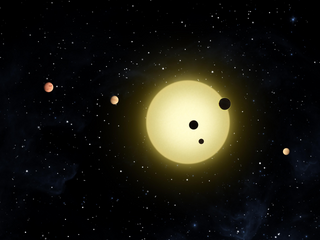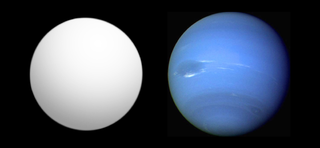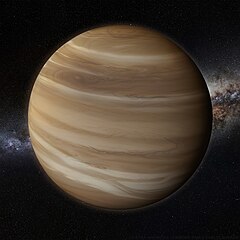
A giant planet, sometimes referred to as a jovian planet, is a diverse type of planet much larger than Earth. Giant planets are usually primarily composed of low-boiling point materials (volatiles), rather than rock or other solid matter, but massive solid planets can also exist. There are four such planets in the Solar System: Jupiter, Saturn, Uranus, and Neptune. Many extrasolar giant planets have been identified.

Hot Jupiters are a class of gas giant exoplanets that are inferred to be physically similar to Jupiter but that have very short orbital periods. The close proximity to their stars and high surface-atmosphere temperatures resulted in their informal name "hot Jupiters".

Gliese 436 is a red dwarf located 31.9 light-years away in the zodiac constellation of Leo. It has an apparent visual magnitude of 10.67, which is much too faint to be seen with the naked eye. However, it can be viewed with even a modest telescope of 2.4 in (6 cm) aperture. In 2004, the existence of an extrasolar planet, Gliese 436 b, was verified as orbiting the star. This planet was later discovered to transit its host star.

Gliese 436 b is a Neptune-sized exoplanet orbiting the red dwarf Gliese 436. It was the first hot Neptune discovered with certainty and was among the smallest-known transiting planets in mass and radius, until the much smaller Kepler exoplanet discoveries began circa 2010.

A Super-Earth is a type of exoplanet with a mass higher than Earth's, but substantially below those of the Solar System's ice giants, Uranus and Neptune, which are 14.5 and 17 times Earth's, respectively. The term "super-Earth" refers only to the mass of the planet, and so does not imply anything about the surface conditions or habitability. The alternative term "gas dwarfs" may be more accurate for those at the higher end of the mass scale, although "mini-Neptunes" is a more common term.
This page describes exoplanet orbital and physical parameters.

An exoplanet is a planet located outside the Solar System. The first evidence of an exoplanet was noted as early as 1917, but was not recognized as such until 2016; no planet discovery has yet come from that evidence. What turned out to be the first detection of an exoplanet was published among a list of possible candidates in 1988, though not confirmed until 2003. The first confirmed detection came in 1992, with the discovery of terrestrial-mass planets orbiting the pulsar PSR B1257+12. The first confirmation of an exoplanet orbiting a main-sequence star was made in 1995, when a giant planet was found in a four-day orbit around the nearby star 51 Pegasi. Some exoplanets have been imaged directly by telescopes, but the vast majority have been detected through indirect methods, such as the transit method and the radial-velocity method. As of 1 April 2024, there are 5,653 confirmed exoplanets in 4,161 planetary systems, with 896 systems having more than one planet. This is a list of the most notable discoveries.

Kepler-11, also designated as 2MASS J19482762+4154328, is a Sun-like star slightly larger than the Sun in the constellation Cygnus, located some 2,110 light years from Earth. It is located within the field of vision of the Kepler spacecraft, the satellite that NASA's Kepler Mission uses to detect planets that may be transiting their stars. Announced on February 2, 2011, the star system is among the most compact and flattest systems yet discovered. It is the first discovered case of a star system with six transiting planets. All discovered planets are larger than Earth, with the larger ones being about Neptune's size.

Kepler-11b is an exoplanet discovered around the star Kepler-11 by the Kepler spacecraft, a NASA-led mission to discover Earth-like planets. Kepler-11b is less than about three times as massive and twice as large as Earth, but it has a lower density, and is thus most likely not of Earth-like composition. Kepler-11b is the hottest of the six planets in the Kepler-11 system, and orbits more closely to Kepler-11 than the other planets in the system. Kepler-11b, along with its five counterparts, form the first discovered planetary system with more than three transiting planets—the most densely packed known planetary system. The system is also the flattest known planetary system. The discovery of this planet and its five sister planets was announced on February 2, 2011, after follow-up investigations.

Kepler-11c is an exoplanet discovered in the orbit of the Sun-like star Kepler-11 by the Kepler spacecraft, a NASA telescope aiming to discover Earth-like planets. It is the second planet from its star, and is most likely a water planet with a thin hydrogen–helium atmosphere. Kepler-11c orbits Kepler-11 every 10 days, and has an estimated density twice that of pure water. It is estimated to have a mass thirteen times that of Earth and a radius three times that of Earth. Kepler-11c and its five sister planets form the first discovered system with more than three transiting planets. The Kepler-11 system also holds the record of being the most compact and the flattest system discovered. Kepler-11c and the other Kepler-11 planets were announced to the public on February 2, 2011, and was published in Nature a day later.

Kepler-11d is an exoplanet discovered in the orbit of the sun-like star Kepler-11. It is named for the telescope that discovered it, a NASA spacecraft named Kepler that is designed to detect Earth-like planets by measuring small dips in the brightness of their host stars as the planets cross in front. This process, known as the transit method, was used to note the presence of six planets in orbit around Kepler-11, of which Kepler-11d is the third from its star. Kepler-11d orbits Kepler-11 well within the orbit of Mercury approximately every 23 days. The planet is approximately six times more massive than the Earth, and has a radius that is three and a half times larger than that of Earth's. It is, however, far hotter than Earth is. Its low density, comparable to that of Saturn, suggests that Kepler-11d has a large hydrogen–helium atmosphere. Kepler-11d was announced with its five sister planets on February 2, 2011 after extensive follow-up studies.

Kepler-11e is an exoplanet discovered in the orbit of the sunlike star Kepler-11. It is the fourth of six planets around Kepler-11 discovered by NASA's Kepler spacecraft. Kepler-11e was found by using the transit method, in which the dimming effect that a planet causes as it crosses in front of its star is measured. Kepler-11e is most likely a gas giant like Neptune, having a density that is less than that of Saturn, the least dense planet in the Solar System. Its low density can probably be attributed to a large hydrogen and helium atmosphere. Kepler-11e has a mass eight times of Earth's mass and a radius 4.5 times that of Earth. The planet orbits its star every 31 days in an ellipse that would fit within the orbit of Mercury. Kepler-11e was announced on February 2, 2011 with its five sister planets after it was confirmed by several observatories.

Kepler-11g is an exoplanet discovered in the orbit of the sunlike star Kepler-11 by the Kepler spacecraft, a NASA satellite tasked with searching for terrestrial planets. Kepler-11g is the outermost of the star's six planets. The planet orbits at a distance of nearly half the mean distance between Earth and the Sun. It completes an orbit every 118 days, placing it much further from its star than the system's inner five planets. Its estimated radius is a little over three times that of Earth, i.e. comparable to Neptune's size. Kepler-11g's distance from the inner planets made its confirmation more difficult than that of the inner planets, as scientists had to work to exhaustively disprove all reasonable alternatives before Kepler-11g could be confirmed. The planet's discovery, along with that of the other Kepler-11 planets, was announced on February 2, 2011. According to NASA, the Kepler-11 planets form the flattest and most compact system yet discovered.

A Mini-Neptune is a planet less massive than Neptune but resembling Neptune in that it has a thick hydrogen-helium atmosphere, probably with deep layers of ice, rock or liquid oceans.

A gas giant is a giant planet composed mainly of hydrogen and helium. Jupiter and Saturn are the gas giants of the Solar System. The term "gas giant" was originally synonymous with "giant planet". However, in the 1990s, it became known that Uranus and Neptune are really a distinct class of giant planets, being composed mainly of heavier volatile substances. For this reason, Uranus and Neptune are now often classified in the separate category of ice giants.

GJ 3470 b is an exoplanet orbiting the star GJ 3470, located in the constellation Cancer. With a mass of just under 14 Earth-masses and a radius approximately 4.3 times that of Earth's, it is likely something akin to Neptune despite the initially strong belief that the planet was not covered in clouds like the gas giants in the Solar System.

Kepler-56b (KOI-1241.02) is a hot Neptune—a class of exoplanets—located roughly 3,060 light-years away. It is somewhat larger than Neptune and orbits its parent star Kepler-56 and was discovered in 2013 by the Kepler Space Telescope.
GJ 9827 is a star in the constellation of Pisces. It is a K-type main-sequence star with an apparent magnitude of 10.250. It is 97 light-years away, based on parallax.
GJ 3470 is a red dwarf star located in the constellation of Cancer, 96 light-years away from Earth. With a faint apparent magnitude of 12.3, it is not visible to the naked eye. It hosts one known exoplanet.

















